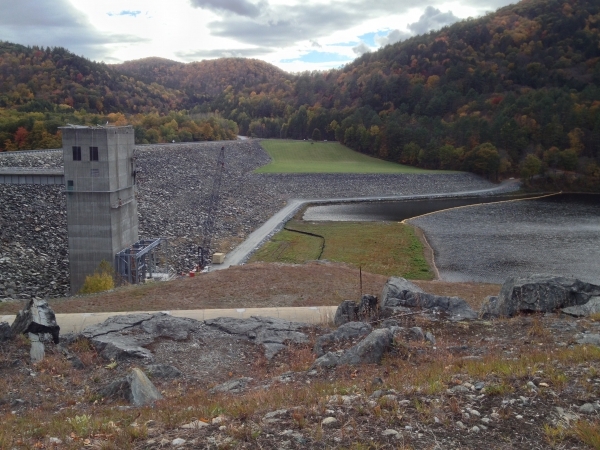TOWNSHEND — As operations chief of the U.S. Army Corps of Engineers New England District, Frank Fedele oversees a $47 million budget, 33 flood-management projects and 116 recreation areas.
Lately, though, he and his staff have been hearing a lot about one particular Army Corps property – Townshend Dam. And the conversations have not been pleasant, with town officials joining state and federal legislators in raising economic and environmental concerns about the site.
Fedele said the Army Corps, after hearing from Vermont's congressional delegation over the past few weeks, is trying to find money for a dredging project to temporarily alleviate sedimentation issues at the dam's swimming area. But he made no guarantees, citing a tight budget both regionally and nationwide.
“We have limited dollars,” Fedele said. “That project (Townshend Dam) is still funded for recreation. We are still trying to do everything we possibly can for recreational opportunities there.”
The 55-year-old Townshend Dam is part of a network of flood-control projects built by the federal government, and it has done its part: As of 2014, the Army Corps estimated that the Townshend facility had prevented more than $141 million in downstream flood damages.
But there have been some significant ripples in the pond in recent years. One ongoing issue is the relatively small payment in lieu of taxes that Townshend receives for hosting the dam via the Connecticut River Valley Flood Control Commission.
Another complaint is that Townshend Lake seems to be slowly disappearing due to excessive sedimentation – a problem that severely impacts recreational activities at the dam.
At a March 11 meeting of the flood control commission in Greenfield, Mass., the tax-payment issue wasn't up for discussion. But Fedele, who visited to give an overview of Army Corps operations in the region, got an earful about the chronically low water levels in Townshend.
“The way it is currently operated and maintained, there is no recreation,” said Bob DeSiervo, a Townshend Planning Commission member who lives near the dam. “You can't boat there, you can't fish there, you can't swim there.”
It is more than a quality of life issue: Because there are fewer people traveling to the once-popular recreation area and to Townshend State Park, local officials say they're seeing economic impacts.
“What we're trying to do is to get (the lake) back to the original way it was promised to the town and the people who use the facility,” DeSiervo told Fedele.
He also expressed frustration at what some perceive as a fatalistic attitude toward the lake's demise. “There doesn't seem to be any interest in making it a recreational area again,” DeSiervo said. “Everyone throws up their hands and says, 'It is what it is.'”
Fedele doesn't see it that way. For one thing, he pointed out that Townshend still has recreational facilities and attracted nearly 34,000 visitors in 2015 – though locals contend that's a fraction of past visitation.
Officials also note that the Army Corps has worked to keep Townshend's swim area open, investing about $28,000 in an excavation/dredging project in 2013.
Two years earlier, after Tropical Storm Irene's floodwaters swept through the area, “that beach was silted up so that, if you did go in there, you'd get stuck in the mud up to your knees,” Fedele said.
But the excavation's benefits were short-lived. During a November meeting at the dam, an Army Corps official estimated that the average depth in most of the lake was just 1 to 2 feet.
Irene-related erosion problems upstream are “still contributing to downstream flow of sediment, and it's ending up in that pool behind Townshend Dam,” Fedele said. “So, we got two years out of that beach-cleaning (project), and it's filled back up again.”
There was talk at the March 11 meeting of the importance of stabilizing stream and river banks upstream before spending more federal money to remove sediment at Townshend Dam. Vermont state agencies may play a role in that work.
But DeSiervo argued that such work may be too far in the future. “We need to get something done, and it can't be 50 years down the road when all the banks eventually get vegetated and stabilized,” he said.
The members of Vermont's congressional delegation, who have pledged help for Townshend, apparently feel the same way.
“The Corps has been in discussions with them,” Fedele said. “Over the last two weeks, we've had two calls with them. They're asking, 'What is it we can do?'”
As a result, Fedele said officials are trying to determine whether they can “reprogram” funding within the current Army Corps budget to attempt a new dredging project at Townshend. If it happens – and Fedele stressed that there are “no promises being made” – it may be a relatively small-scale project similar to the 2013 excavation.
“If we can do this again – if we had some funding to do this again – we're looking at what's available,” Fedele said.
But there doesn't appear to be much wiggle room in the Army Corps budget. Fedele said the regional spending plan for fiscal year 2015 was $3.5 million less than in fiscal year 2012.
“We have 50- to 60-year-old infrastructure now, so there's a lot of maintenance that we're trying to do to stay on top of it,” he said. “But, given our stable or declining budget, it becomes more and more challenging.”
Furthermore, a budget breakdown for the New England Region shows that the Army Corps' emphasis is not on recreational areas. Recreation is the third-largest budget line item at $4.9 million but is far outpaced by navigation ($12.9 million) and flood-risk management ($25.7 million).
Townshend's sedimentation issues, Fedele added, have no significant impact on the dam's floodwater-storage capacity.
“These projects were built for flood-risk management,” Fedele said. “That's our primary mission.”
